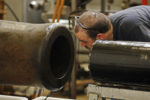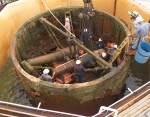 It has taken 158 years but it is now possible to stare down the freshly-cleaned barrel of one the Dahlgren guns from the USS Monitor. The ironclad Monitor engaged the Confederate ironclad Virginia, formerly the USS Merrimack, on March 9th, 1862. It went down in history as the first battle in history between ironclad battleships. Less than a year later, the Monitor sank in a storm off the coast of Cape Hatteras, North Carolina.
It has taken 158 years but it is now possible to stare down the freshly-cleaned barrel of one the Dahlgren guns from the USS Monitor. The ironclad Monitor engaged the Confederate ironclad Virginia, formerly the USS Merrimack, on March 9th, 1862. It went down in history as the first battle in history between ironclad battleships. Less than a year later, the Monitor sank in a storm off the coast of Cape Hatteras, North Carolina.
The wreck was discovered in 1973 and over the decades a few individual pieces were retrieved — the signal lantern, the anchor, personal effects — but in 2002, the Monitor‘s 120-ton gun turret was raised from the wreck site. It contained two XI-inch Dahlgren guns and their carriages.
The Dahlgren guns are 11 feet long and weigh almost eight tons. They were cast at the West Point foundry in 1859 and were originally on another warship before being transferred to the Monitor. A hundred and forty years at the bottom of the Atlantic Ocean had caked it inside and outside with concretion, a rock-hard combination of corrosion materials, sediment and sea life.
 A century and a half in salt water damaged the metal in other ways as well, making the metal brittle. To gradually desalinate them, protecting them from the flash oxidation that would rust them out if they were dried out and ensuring their long-term preservation, the guns were immersed in 4,300-gallon tanks of water and sodium hydroxide at the Mariners’ Museum in Newport News, Virginia. Full desalination was elusive, however, because the full depth of the bore was still lined with concretion inches thick.
A century and a half in salt water damaged the metal in other ways as well, making the metal brittle. To gradually desalinate them, protecting them from the flash oxidation that would rust them out if they were dried out and ensuring their long-term preservation, the guns were immersed in 4,300-gallon tanks of water and sodium hydroxide at the Mariners’ Museum in Newport News, Virginia. Full desalination was elusive, however, because the full depth of the bore was still lined with concretion inches thick.
Concretions are usually removed from the surface of artifacts with power tools or dry ice blasting, but it’s not possible to reach all the way into the bore of a massive cannon. Drilling equipment would be necessary, but without knowing the precise length of the bore, the drill would either not be able to clean the full interior or it would go too far and cut a groove into the back of the bore.
 Conservators studied patent drawings and ordnance records to determine the bore’s length, but there were discrepancies in the measurements for the XI-Inch Dahlgren. In order to ascertain whether the Monitor‘s guns matched the dimensions from the ordnance drawings or the patent drawings, researchers used a simple hardware store laser tape measure and a digital level to take top-to-bottom measurements of the bore of another XI-Inch Dahlgren made at the West Point foundry in 1861. The data gathered was not perfectly precise, but it was good enough to identify the test gun as matching the 1851 Board of Ordnance drawing with a bore length of 131.2″.
Conservators studied patent drawings and ordnance records to determine the bore’s length, but there were discrepancies in the measurements for the XI-Inch Dahlgren. In order to ascertain whether the Monitor‘s guns matched the dimensions from the ordnance drawings or the patent drawings, researchers used a simple hardware store laser tape measure and a digital level to take top-to-bottom measurements of the bore of another XI-Inch Dahlgren made at the West Point foundry in 1861. The data gathered was not perfectly precise, but it was good enough to identify the test gun as matching the 1851 Board of Ordnance drawing with a bore length of 131.2″.
On Tuesday, February 25th, conservators deployed a bespoke drill and bit designed to remove the concretion from the bore of the gun.
After some measurements, adjustments and leveling by the conservation staff, Farrell guided the drill forward on its track, inching it into the gun’s barrel. The drill produced a deluge of black water and some large chunks of marine concretions, giving material culture specialist Hannah Fleming plenty to hammer through — literally. She took a hammer and chisel to some chunks more than a foot long, looking for anything that wasn’t rock.
After about three hours of drilling and chiseling, she hadn’t found anything of note, but one small item caught some of the museum staff’s eye.
…Two decades after the ironclad sank, former crew member Francis Butts wrote that as the Monitor was going down, he stuffed his coat and boots into one of the guns and a black cat into the other. There is no other evidence to support that account, and the museum has not found any signs of a coat or boots, let alone a cat.
When Fleming found something that was hard and not rock, there was a fleeting thought that it may be a remnant of cat. It ended up being a piece of crab.
Here’s Butts’ account which, to quote Bart Simpson’s review of the Krusty autobiography, strikes me as self-serving with many glaring omissions.
I occupied the turret all alone, and passed buckets from the lower hatchway to the man on top of the turret. I took off my coat—one that I had received from home only a few days previous, (I could not feel that our noble little ship was yet lost,) —and rolling it up with my boots, drew the tompion from one of the guns, placed them inside and returned the tompion. We had a black cat on board, which then sat on the breech of one of the guns, howling one of those hoarse and solemn tunes which no one can appreciate, unless filled with the superstitions which I had been taught by the sailors who were afraid to kill a cat. I would almost as soon have touched a ghost, but I caught her and placing her in another gun, replaced the wad and tompion, but could still hear that distressing yeowl. As I raised my last bucket to the upper hatchway no one was there to take it. I scrambled up the ladder and found that we below had been deserted. I shouted to those on the berth deck to “Come up—the officers have left the ship and a boat is alongside.”
The skeletal remains of two sailors were discovered in the gun turret when it was raised in 2002, so Mr. Butts’ last man standing claim has been tragically and conclusively disproved. The two sailors were buried at Arlington National Cemetery in 2013.
The second Dahlgren gun is being bored this week. Here’s hoping there’s no feline in that one either.